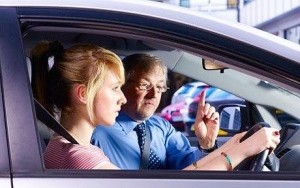Check-out our Defensive Driving Program
Crash-free driving is a mind set and driving method. Crash-free drivers main goal, every time they drive, is to arrive at their destination crash or incident free.
A crash-free driver manages their driving so nothing conflicts with or compromises this goal. It may require them to use tremendous will power, be humble, tolerant and be calm when it may feel better to be angry.
In crash-free driving, drivers also perceive situations in which other road users might move into their crash avoidance space. When this happens a crash-free driver protects this space.
Make no mistake…
Every 3km of driving the average driver makes: 400 observations ~ 40 decisions ~ 1 mistake.
Every 800km; 1 of these mistakes leads to 1 near miss.
Every 100,000km; 1 of these mistakes leads to 1 crash.
 Scanning Techniques ~ Commentary Driving
Scanning Techniques ~ Commentary Driving
A key feature to making your vision techniques work is called `commentary driving’. It will highlight your awareness of traffic hazards and enhance your ability to identify and act upon them while you still have time – before they impact on you.
It will also assist you to prioritise the importance of hazards such as intersections, pedestrian crossings, vehicles, and potential hazards such as parked vehicles and bus stops.
It can be as simple as making short statements out loud such as:
- intersection or roundabout ahead, vehicle at an intersection on my right waiting to drive out.
- the speed limit is 60 kph, my speed is 65 kph.
- vehicles behind me have good following distances (use mirrors).
- vehicles approaching ahead (scan at least 12 seconds ahead).
- pedestrian on the left footpath’.
Once you have developed this skill, also suggest the action you’ll take. For example, `vehicle on my right waiting to come out – check mirrors, establish eye contact, cover brake’.
Commentary driving is acknowledged as a major cause of increased in-car safety
Driving Hazards
There are two types of driving dangers that a defensive driver is aware of and makes judgement on to reduce the risk of being involved in a vehicle incident whether it is their fault or not.
A hazard is anything that contains an element of Actual or Potential danger.
Actual hazards (What is the Risk) are things that exist but there is nothing a driver can do to change the situations i.e. road and weather conditions, corners, crest, intersections, pedestrians, unfenced areas, road-trains, approaching vehicles, kangaroos and wildlife.
Potential dangers (What is the potential danger) are worst-case situations that may result from the actual hazard, the `what if’ factor i.e. a driver failing to stop/give way at an intersection, a vehicle coming around a corner on your side of the road at speed, a pedestrian walking/running in front of you, wildlife, loose gravel, potholes, soft edges, and dust etc.
What is your action to prevent being involved in a vehicle incident expecting the unexpected, continue scanning, slow down, ease of the accelerator, resting you foot over the brake pedal are some of many actions you can do to prevent being involved in a vehicle incident..
Drivers are people and people make mistakes, no one is perfect.
Sooner or later, we will make a mistake when driving; some of us will live but unfortunately some will not.
A Defensive Driver continues to scan for actual hazards, considers potential dangers,
knows the defence required and is prepared to take evasive action, “all of the time”.
|
What is the |
What is the Potential Danger |
What is your actionsto aviod this hazard |
| Road Conditions. | Potholes, rough section, loose gravel, road edge, slippery and wet conditions, narrow roads, other drivers experience for different road conditions. |
? |
| Intersections traffic lightsroundabouts– merging. | Drivers failing to stop / give way, pedestrians, drivers not seeing you, knowledge of road rules. |
? |
| Corners / bends. | Vehicle travelling on your side of the road, wildlife, bike riders, speed, loose/slippery road. |
? |
| Other Vehicles and Drivers. | Fatigue, alcohol, drugs, driver mistakes, faulty vehicle, experience, unacceptable driving behaviors. |
? |
| Residential area. | Kids, animals, reversing vehicles, school zone. |
? |
| Farm / rural areas. | Kangaroos, emus, pigs, horses, cows, wildlife, etc. |
? |
| Road train approaching you on a single lane bitumen road. |
? |
? |
| Crest or bend on a narrow single lane bitumen surface. |
? |
? |
